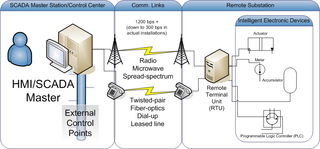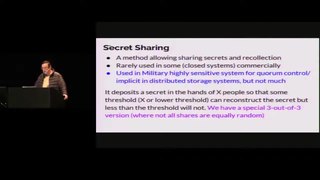Related Research Articles

Diffie–Hellman key exchange is a mathematical method of securely exchanging cryptographic keys over a public channel and was one of the first public-key protocols as conceived by Ralph Merkle and named after Whitfield Diffie and Martin Hellman. DH is one of the earliest practical examples of public key exchange implemented within the field of cryptography. Published in 1976 by Diffie and Hellman, this is the earliest publicly known work that proposed the idea of a private key and a corresponding public key.

In cryptography, encryption is the process of encoding information. This process converts the original representation of the information, known as plaintext, into an alternative form known as ciphertext. Ideally, only authorized parties can decipher a ciphertext back to plaintext and access the original information. Encryption does not itself prevent interference but denies the intelligible content to a would-be interceptor.

Public-key cryptography, or asymmetric cryptography, is the field of cryptographic systems that use pairs of related keys. Each key pair consists of a public key and a corresponding private key. Key pairs are generated with cryptographic algorithms based on mathematical problems termed one-way functions. Security of public-key cryptography depends on keeping the private key secret; the public key can be openly distributed without compromising security.
In computing, Internet Protocol Security (IPsec) is a secure network protocol suite that authenticates and encrypts packets of data to provide secure encrypted communication between two computers over an Internet Protocol network. It is used in virtual private networks (VPNs).
Quantum key distribution (QKD) is a secure communication method that implements a cryptographic protocol involving components of quantum mechanics. It enables two parties to produce a shared random secret key known only to them, which then can be used to encrypt and decrypt messages. The process of quantum key distribution is not to be confused with quantum cryptography, as it is the best-known example of a quantum-cryptographic task.
In cryptography and computer security, a man-in-the-middle (MITM) attack is a cyberattack where the attacker secretly relays and possibly alters the communications between two parties who believe that they are directly communicating with each other, as the attacker has inserted themselves between the two parties. One example of a MITM attack is active eavesdropping, in which the attacker makes independent connections with the victims and relays messages between them to make them believe they are talking directly to each other over a private connection, when in fact the entire conversation is controlled by the attacker. The attacker must be able to intercept all relevant messages passing between the two victims and inject new ones. This is straightforward in many circumstances; for example, an attacker within the reception range of an unencrypted Wi-Fi access point could insert themselves as a man-in-the-middle. As it aims to circumvent mutual authentication, a MITM attack can succeed only when the attacker impersonates each endpoint sufficiently well to satisfy their expectations. Most cryptographic protocols include some form of endpoint authentication specifically to prevent MITM attacks. For example, TLS can authenticate one or both parties using a mutually trusted certificate authority.

A public key infrastructure (PKI) is a set of roles, policies, hardware, software and procedures needed to create, manage, distribute, use, store and revoke digital certificates and manage public-key encryption. The purpose of a PKI is to facilitate the secure electronic transfer of information for a range of network activities such as e-commerce, internet banking and confidential email. It is required for activities where simple passwords are an inadequate authentication method and more rigorous proof is required to confirm the identity of the parties involved in the communication and to validate the information being transferred.
A cryptosystem is considered to have information-theoretic security if the system is secure against adversaries with unlimited computing resources and time. In contrast, a system which depends on the computational cost of cryptanalysis to be secure is called computationally, or conditionally, secure.

Internet security is a branch of computer security. It encompasses the Internet, browser security, web site security, and network security as it applies to other applications or operating systems as a whole. Its objective is to establish rules and measures to use against attacks over the Internet. The Internet is an inherently insecure channel for information exchange, with high risk of intrusion or fraud, such as phishing, online viruses, trojans, ransomware and worms.
In symmetric key cryptography, both parties must possess a secret key which they must exchange prior to using any encryption. Distribution of secret keys has been problematic until recently, because it involved face-to-face meeting, use of a trusted courier, or sending the key through an existing encryption channel. The first two are often impractical and always unsafe, while the third depends on the security of a previous key exchange.
In cryptography, forward secrecy (FS), also known as perfect forward secrecy (PFS), is a feature of specific key-agreement protocols that gives assurances that session keys will not be compromised even if long-term secrets used in the session key exchange are compromised. For HTTPS, the long-term secret is typically the private key of the server. Forward secrecy protects past sessions against future compromises of keys or passwords. By generating a unique session key for every session a user initiates, the compromise of a single session key will not affect any data other than that exchanged in the specific session protected by that particular key. This by itself is not sufficient for forward secrecy which additionally requires that a long-term secret compromise does not affect the security of past session keys.

Distributed Network Protocol 3 (DNP3) is a set of communications protocols used between components in process automation systems. Its main use is in utilities such as electric and water companies. Usage in other industries is not common. It was developed for communications between various types of data acquisition and control equipment. It plays a crucial role in SCADA systems, where it is used by SCADA Master Stations, Remote Terminal Units (RTUs), and Intelligent Electronic Devices (IEDs). It is primarily used for communications between a master station and RTUs or IEDs. ICCP, the Inter-Control Center Communications Protocol, is used for inter-master station communications. Competing standards include the older Modbus protocol and the newer IEC 61850 protocol.
Mutual authentication or two-way authentication refers to two parties authenticating each other at the same time in an authentication protocol. It is a default mode of authentication in some protocols and optional in others (TLS).
TSIG is a computer-networking protocol defined in RFC 2845. Primarily it enables the Domain Name System (DNS) to authenticate updates to a DNS database. It is most commonly used to update Dynamic DNS or a secondary/slave DNS server. TSIG uses shared secret keys and one-way hashing to provide a cryptographically secure means of authenticating each endpoint of a connection as being allowed to make or respond to a DNS update.
A wireless ad hoc network (WANET) or mobile ad hoc network (MANET) is a decentralized type of wireless network. The network is ad hoc because it does not rely on a pre-existing infrastructure, such as routers or wireless access points. Instead, each node participates in routing by forwarding data for other nodes. The determination of which nodes forward data is made dynamically on the basis of network connectivity and the routing algorithm in use.

A physical unclonable function, or PUF, is a physical object that for a given input and conditions (challenge), provides a physically defined "digital fingerprint" output (response) that serves as a unique identifier, most often for a semiconductor device such as a microprocessor. PUFs are often based on unique physical variations occurring naturally during semiconductor manufacturing. A PUF is a physical entity embodied in a physical structure. PUFs are implemented in integrated circuits, including FPGAs, and can be used in applications with high-security requirements, more specifically cryptography, Internet of Things (IOT) devices and privacy protection.

Multi-factor authentication is an electronic authentication method in which a user is granted access to a website or application only after successfully presenting two or more pieces of evidence to an authentication mechanism. MFA protects personal data—which may include personal identification or financial assets—from being accessed by an unauthorized third party that may have been able to discover, for example, a single password.
Quantum cryptography is the science of exploiting quantum mechanical properties to perform cryptographic tasks. The best known example of quantum cryptography is quantum key distribution, which offers an information-theoretically secure solution to the key exchange problem. The advantage of quantum cryptography lies in the fact that it allows the completion of various cryptographic tasks that are proven or conjectured to be impossible using only classical communication. For example, it is impossible to copy data encoded in a quantum state. If one attempts to read the encoded data, the quantum state will be changed due to wave function collapse. This could be used to detect eavesdropping in quantum key distribution (QKD).

Mordechai M. "Moti" Yung is a cryptographer and computer scientist known for his work on cryptovirology and kleptography.

Atta ur Rehman Khan is a computer scientist and academician who has contributed to multiple domains of the field. According to a Stanford University report, he is among World's Top 2% Scientists. He is the founder of National Cyber Crime Forensics Lab Pakistan, which operates in partnership with NR3C. He has published numerous research articles and books. He is a senior member of IEEE and ACM.
References
- ↑ "Home". infocom2010.ieee-infocom.org.
- ↑ Xiao, Sheng, Weibo Gong, and Don Towsley. "Secure wireless communication with dynamic secrets." INFOCOM, 2010 Proceedings IEEE. IEEE, 2010.
- ↑ Xiao, Sheng; Gong, Weibo; Towsley, Don (August 22, 2013). Dynamic Secrets in Communication Security. Springer. p. 150. ISBN 978-1461478300.